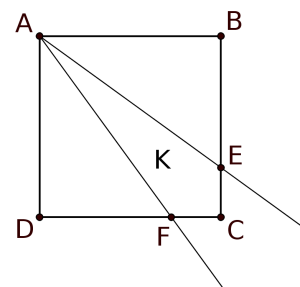
________________
Coach Newton surprises the team with another practice on fractions. “Awww! those last fraction problems were hard,” complain the students, but the coach responds, “Don’t worry, these are from two dimensions, not three, so give ’em a shot.”
________________
Equitable Area
Equitable Area
Both problems today revolve around the diagram to the right, which was the subject of a recent debate by team members on the most beautiful way to divide a square into three pieces by two rays from the same vertex, each making the same angle to its nearest side. Lisa contends that the best way to divide is so that the areas of all three sections end up equal.
revolve around the diagram to the right, which was the subject of a recent debate by team members on the most beautiful way to divide a square into three pieces by two rays from the same vertex, each making the same angle to its nearest side. Lisa contends that the best way to divide is so that the areas of all three sections end up equal.
What fraction should the length of segment CF be of FD to make that happen?
Angular Equity
Conversely, Quinn maintains that the diagram is more attractive if all three angles at vertex A are equal.
What is the area of triangle ADF divided by the area of region K if the diagram is drawn according to Quinn’s preference?
| Spread the word: | Tweet |
Solutions to week 55
Diagonalization. One way to attack this is by looking at smaller numbers of points first.  A triangle has zero diagonals; a square has two diagonals; a pentagon has five diagonals (imagine a five-pointed star inscribed in the pentagon); and a hexagon has three diagonals that go all the way across and six diagonals that form two overlapping triangles (see the diagram) for a total of nine diagonals. Looking at this sequence of numbers of diagonals (0, 2, 5, 9, …) it appears that the difference between successive terms grows by one each time, so it seems the heptagon should have 14 diagonals.
A triangle has zero diagonals; a square has two diagonals; a pentagon has five diagonals (imagine a five-pointed star inscribed in the pentagon); and a hexagon has three diagonals that go all the way across and six diagonals that form two overlapping triangles (see the diagram) for a total of nine diagonals. Looking at this sequence of numbers of diagonals (0, 2, 5, 9, …) it appears that the difference between successive terms grows by one each time, so it seems the heptagon should have 14 diagonals.
To see this another way that will increase our confidence over just extrapolating from a pattern, consider any one of the vertices of the heptagon. There are four other vertices it can connect to, in order to create a diagonal. (That is, all of the seven vertices minus itself and its two nearest neighbors.) Since each of the seven vertices can connect to four others to make a diagonal, it seems at first as though there should be seven times four, or 28, diagonals. But then we realize that in this way we counted each diagonal twice, once from each vertex that it connects. So the actual number of diagonals should be half that, or 14, which agrees with the pattern we noticed.
Regionalization. Obviously the circle starts out with one region before any lines have been drawn. Whenever a line is added, it splits at least one region into two, adding one to the number of regions. But it may split multiple regions. How can you tell how many regions it splits? For each other line it crosses, it encounters a new region which it splits. Therefore, the new line adds one more region for each other line it crosses. If we add this up for all lines, the number of regions will be one (the original circle) plus the number of lines plus the number of crossings. In the case of the heptagon, we know that there are 21 lines in all, between the seven sides of the heptagon and the 14 diagonals found in the previous problem. But how many crossings are there? Any group of four vertices creates one crossing, from the lines that connect opposite points: and moreover, from any one crossing you can follow the four segments that reach there to find a group of four vertices on the circle. So the number of crossings is the same as the number of groups of four vertices. Since we can use any combination of four vertices, this is the number of combinations of seven things taken four at a time, which has the formula 7!/4!3! = 35. Thus there are a total of 1 + 21 + 35 = 57 regions.
I gave you these two problems as a cautionary tale on trusting patterns that you see in a few examples. Sometimes it works, like in Diagonalization; but other times, like in Regionalization, it can lead you astray. By looking at the cases of two points (two regions), three points (four regions), four points (eight regions), and even five points (16 regions), you might jump to the conclusion that the number of regions doubles with every additional point, and thereby guess the incorrect value of 64 for the number of regions generated by seven points. The pattern only breaks down for the first time in the case of six points (which generate 31 regions, not 32), underscoring the need to find independent reasoning to establish your answer even when you think you’ve seen the pattern in the information relating to the problem.
Recent Weeks
Week 55: Diagonalization & Regionalization, solutions to Watch for Falling Nuts & Fall Out of Line
Week 54: Watch for Falling Nuts & Fall Out of Line, solutions to Hexadiagonal & Hexintersection
Week 53: Hexadiagonal & Hexintersection, solutions to Mean Triangle & As Easy as 4132
Week 52: Mean Triangle & As Easy as 4132, solutions to Rhombarium & Well Trained
Week 51: Rhombarium & Well Trained, solutions to Olympic Unity & Try Jump
Links to all of the puzzles and solutions are on the Complete Varsity Math page.
Come back next week for answers and more puzzles.
[asciimathsf]














